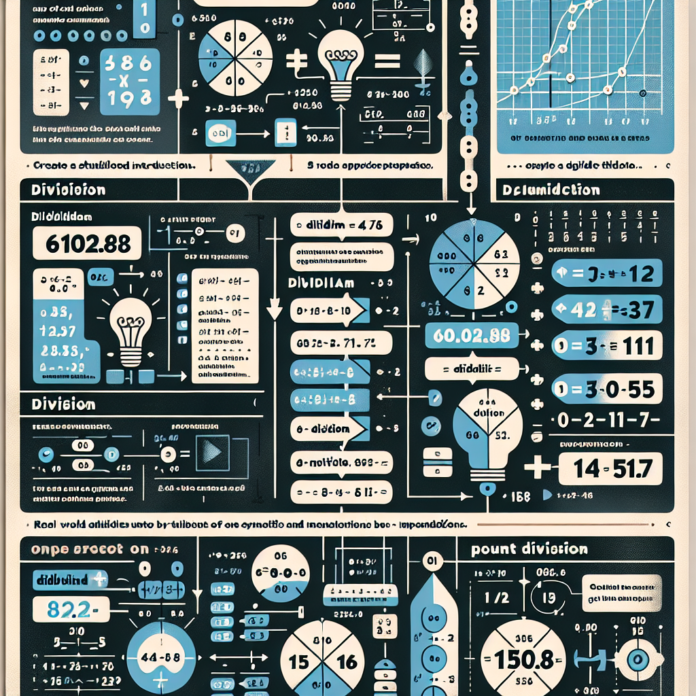Mathematics, with its diverse branches and complex concepts, often presents challenges and opportunities for learners and enthusiasts alike. Among the fundamental operations, division stands out as a crucial component in mathematics, playing a significant role in problem-solving and analytical thinking. This blog post focuses on the intriguing calculation of 602.88 divided by 150.8, exploring its significance and practical applications. Whether you’re a math enthusiast, educator, or student, understanding the nuances of division can greatly enhance your mathematical prowess.
Understanding the Division Process
Before we plunge into the calculation, let’s revisit the basic concepts of division. At its core, division is the process of determining how many times one number (the divisor) can fit into another (the dividend). The result is known as the quotient. These terms—dividend, divisor, and quotient—are essential in comprehending the division operation.
The process of division, specifically long division, involves a series of methodical steps that simplify complex calculations. It begins with estimating how many times the divisor fits into the first part of the dividend. Each step involves multiplication, subtraction, and occasionally, bringing down the next digit from the dividend. This iterative process continues until the entire dividend has been divided.
For instance, consider dividing 602.88 by 150.8. Understanding the division process equips learners with the skills to tackle this challenge efficiently. It emphasizes precision, as each step contributes to the accuracy of the final result. Grasping these essentials builds a strong foundation for tackling more complex mathematical problems.
Calculation Breakdown 602.88 ÷ 150.8
Let’s break down the division of 602.88 by 150.8 using long division, a method revered for its clarity and reliability. Firstly, identify the whole number part of the dividend, which is 602. Align the divisor, 150.8, beneath it. Estimate how many times 150.8 fits into 602; in this case, it’s approximately four times.
Multiply 150.8 by four to get 603.2. Subtract this from 602.88, resulting in a remainder of -0.32. Since the remainder is less than the divisor, bring down the next digit, making it -3.2. Repeat the process, estimating how many times 150.8 fits into -3.2. Since we’re dealing with a negative number, the goal is to make the remainder as close to zero as possible.
Continue refining the quotient until the remainder is minimized. This meticulous approach ensures precision and prevents errors, a crucial practice in mathematical calculations. Understanding each step of the process not only facilitates accurate division but also enhances problem-solving skills.
Real-world Applications
Division is far from being an abstract mathematical concept; it finds application in various real-world scenarios. Businesses, for instance, frequently use division to allocate resources efficiently, calculate profits, and assess productivity. In science, division aids in understanding ratios, proportions, and measurements, enabling accurate experimentation and analysis.
Consider the calculation of 602.88 divided by 150.8 in a business context. Imagine a company distributing $602.88 among 150.8 employees. The division helps determine the amount each employee receives, ensuring fair and equitable distribution. Similarly, division is instrumental in calculating rates, such as determining speed or density, offering practical insights into scientific phenomena.
These examples underscore the importance of division beyond the classroom. By grasping the principles of division, individuals gain a powerful tool for tackling real-world challenges, fostering critical thinking and analytical skills.
Educational Insights
For educators, teaching division effectively is paramount in nurturing students’ mathematical understanding. Division forms the basis for more advanced mathematical concepts, making it imperative to introduce it in an engaging and comprehensible manner. Interactive methods, such as visual aids, manipulatives, and real-life examples, enhance students’ grasp of division.
Incorporating technology, such as educational apps and online resources, can make learning division enjoyable and interactive. Gamified exercises and virtual simulations provide opportunities for hands-on learning, catering to diverse learning styles. By fostering a positive attitude towards division, educators empower students to explore mathematical concepts with confidence.
Furthermore, emphasizing the relevance of division in everyday life bridges the gap between theory and application. Demonstrating how division is used in cooking, budgeting, and sports, for instance, highlights its practical significance. These insights cultivate a deeper appreciation for mathematics and its role in shaping our understanding of the world.
Conclusion
In conclusion, the exploration of 602.88 divided by 150.8 unveils the intricate nature of division and its widespread applications. From understanding the division process to recognizing its real-world significance, division emerges as a fundamental mathematical skill. Educators play a vital role in imparting this knowledge, equipping students with the tools to excel in both academics and life.

